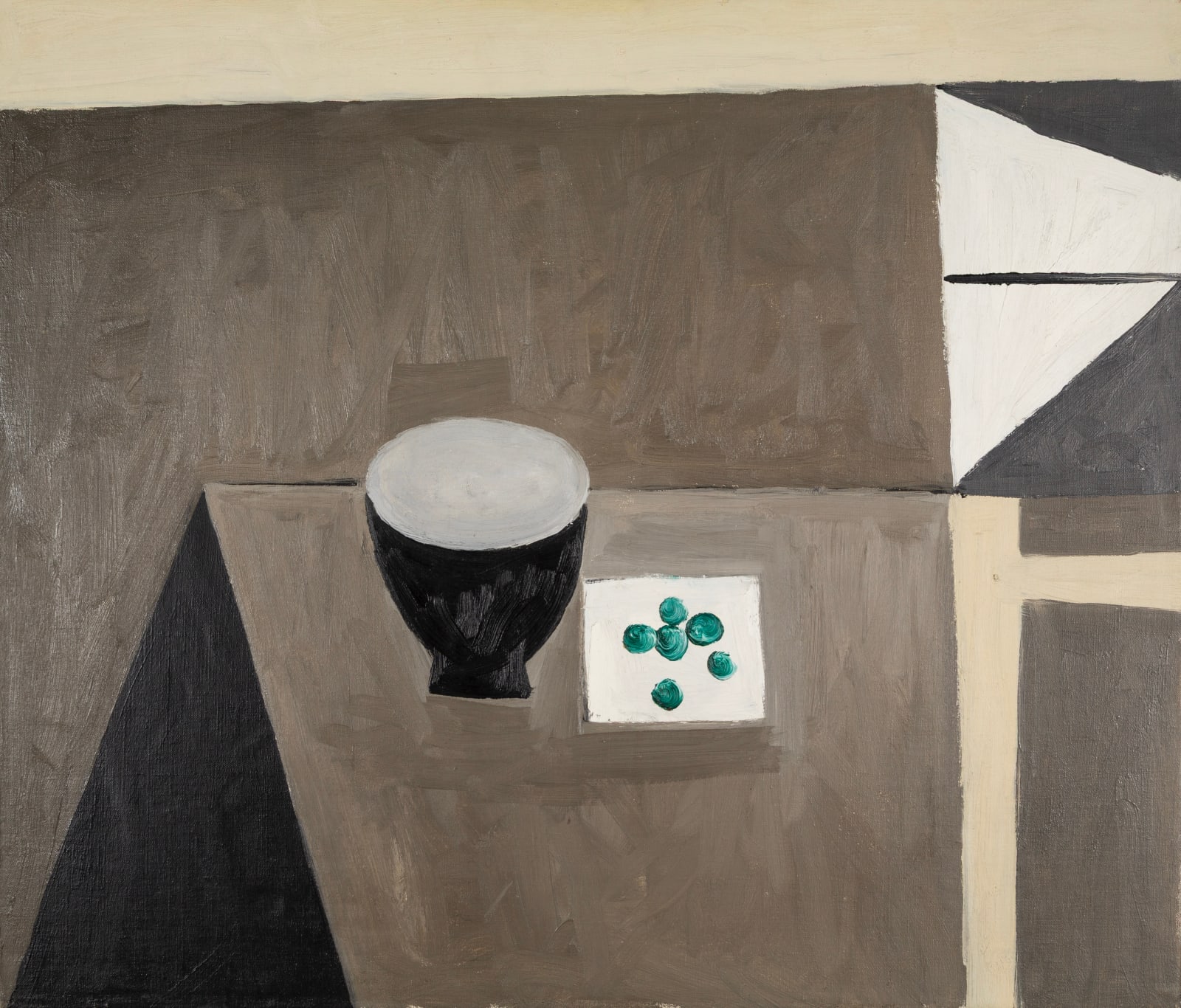William Scott 1913-1989
Still Life with Bowl and Olives, 1950
oil on canvas
55.5 x 64 cm
21 7/8 x 25 1/4 in
21 7/8 x 25 1/4 in
William Scott's Still Life with Bowl and Olives (1950) stands at a crucial turning point in the artist's career, as his still-life paintings shifted away from descriptive realism toward an...
William Scott's Still Life with Bowl and Olives (1950) stands at a crucial turning point in the artist's career, as his still-life paintings shifted away from descriptive realism toward an austere, abstracted language. The composition is pared down to its essentials: a dark bowl placed at the centre of the table, a square plate with just a handful of green olives, and the surrounding planes of grey and brown. What might otherwise be a domestic scene becomes something closer to a meditation on balance, geometry, and space.
Scott reduces his colours to earthy greys and blacks, punctuated only by the vivid green of the olives. This severe economy heightens the formal clarity of the work and emphasises the relationships between shapes and surfaces. In this respect, the painting resonates with the pared-back post-war still lifes of Picasso, particularly 'Nature morte au Poron' (1948), who similarly turned the kitchen table into a stage for abstraction and experimentation. Yet Scott's interpretation is distinctively his own—less flamboyant, more contemplative, and deeply attuned to a quiet, architectural order. For Scott, this dialogue with Picasso was not imitation but transformation, an absorption of the innovations of continental modernism which he made his own.
The date of 1950 is significant. That year, Scott held his first solo exhibition at the Leicester Galleries in London, marking his emergence as one of the leading voices of post-war British painting. 'Still Life with Bowl and Olives' demonstrates his absorption of European modernism, as well as his determination to forge a personal idiom within it. By transforming the humble still life into an arena for formal and spatial exploration, Scott aligned himself with the international avant-garde while remaining rooted in his own artistic concerns.
This painting not only encapsulates Scott's early move towards abstraction but also foreshadows the serene, elemental works of the 1950s and 1960s that would establish him as a central figure in modern British art. Scott painted two very similar versions of this subject but with essential differences - one version was gifted as a wedding present to Henry Cliffe, a fellow artist and colleague from Corsham. The second version, this one, was slightly larger and kept by Scott himself. The painting has remained in the family collection until now.
Scott reduces his colours to earthy greys and blacks, punctuated only by the vivid green of the olives. This severe economy heightens the formal clarity of the work and emphasises the relationships between shapes and surfaces. In this respect, the painting resonates with the pared-back post-war still lifes of Picasso, particularly 'Nature morte au Poron' (1948), who similarly turned the kitchen table into a stage for abstraction and experimentation. Yet Scott's interpretation is distinctively his own—less flamboyant, more contemplative, and deeply attuned to a quiet, architectural order. For Scott, this dialogue with Picasso was not imitation but transformation, an absorption of the innovations of continental modernism which he made his own.
The date of 1950 is significant. That year, Scott held his first solo exhibition at the Leicester Galleries in London, marking his emergence as one of the leading voices of post-war British painting. 'Still Life with Bowl and Olives' demonstrates his absorption of European modernism, as well as his determination to forge a personal idiom within it. By transforming the humble still life into an arena for formal and spatial exploration, Scott aligned himself with the international avant-garde while remaining rooted in his own artistic concerns.
This painting not only encapsulates Scott's early move towards abstraction but also foreshadows the serene, elemental works of the 1950s and 1960s that would establish him as a central figure in modern British art. Scott painted two very similar versions of this subject but with essential differences - one version was gifted as a wedding present to Henry Cliffe, a fellow artist and colleague from Corsham. The second version, this one, was slightly larger and kept by Scott himself. The painting has remained in the family collection until now.
Literature
Sarah Whitfield, 'William Scott Catalogue Raisonné of Oil Paintings 1913-1951', Volume 1, London, Thames and Hudson, 2013, cat. no.182, illustrated in colour1
of
27



